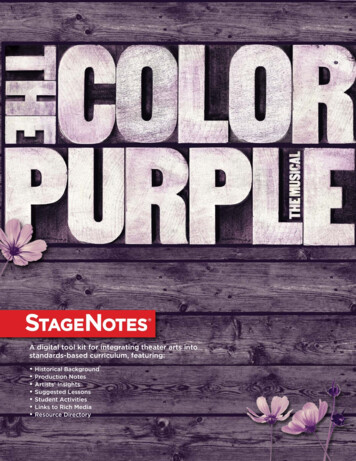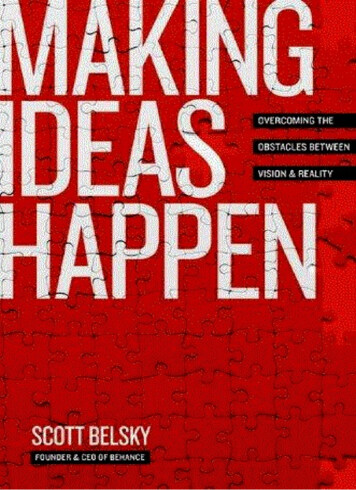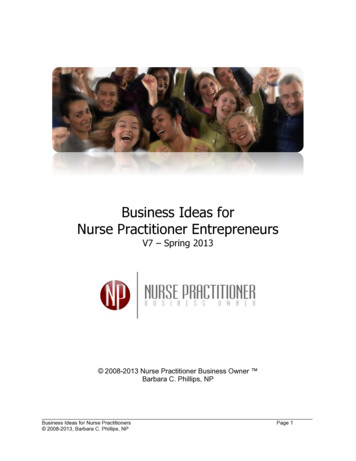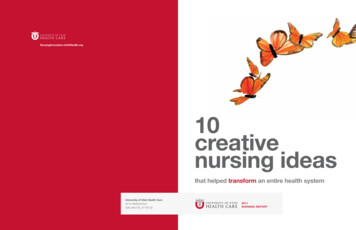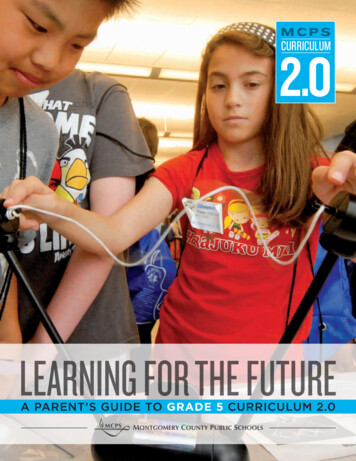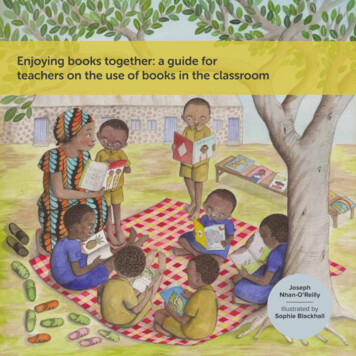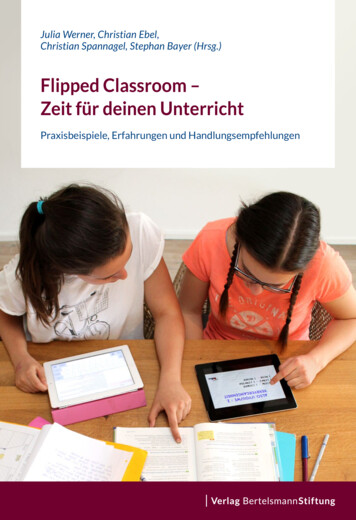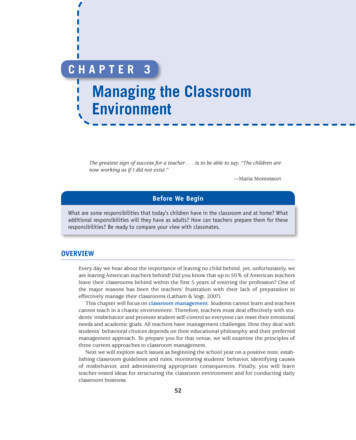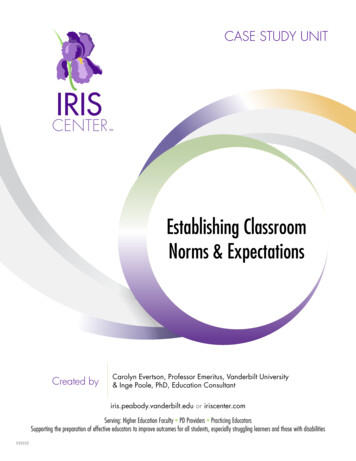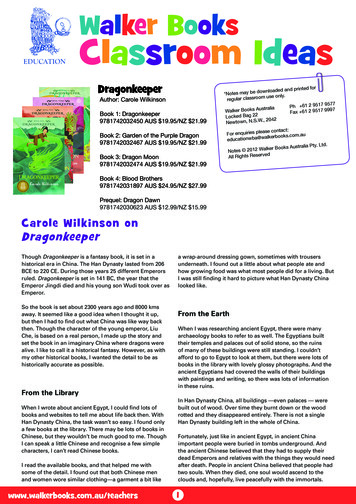
Transcription
Walker BooksClassroom IdeasDragonkeeperAuthor: Carole WilkinsonBook 1: Dragonkeeper9781742032450 AUS 19.95/NZ 21.99Book 2: Garden of the Purple Dragon9781742032467 AUS 19.95/NZ 21.99Book 3: Dragon Moon9781742032474 AUS 19.95/NZ 21.99inted forwnloaded and pr*Notes may be doly.oneusregular classroom9577Ph 61 2 9517stralia97Walker Books Aux 61 2 9517 99FaLocked Bag 22, 2042Newtown, N.S.W.ase contact:For enquiries plelkerbooks.com.auwaa@wbonatiucedalia Pty. Ltd.lker Books AustrNotes 2012 WadAll Rights ReserveBook 4: Blood Brothers9781742031897 AUS 24.95/NZ 27.99Prequel: Dragon Dawn9781742030623 AUS 12.99/NZ 15.99Carole Wilkinson onDragonkeeperThough Dragonkeeper is a fantasy book, it is set in ahistorical era in China. The Han Dynasty lasted from 206BCE to 220 CE. During those years 25 different Emperorsruled. Dragonkeeper is set in 141 BC, the year that theEmperor Jingdi died and his young son Wudi took over asEmperor.So the book is set about 2300 years ago and 8000 kmsaway. It seemed like a good idea when I thought it up,but then I had to find out what China was like way backthen. Though the character of the young emperor, LiuChe, is based on a real person, I made up the story andset the book in an imaginary China where dragons werealive. I like to call it a historical fantasy. However, as withmy other historical books, I wanted the detail to be ashistorically accurate as possible.From the LibraryWhen I wrote about ancient Egypt, I could find lots ofbooks and websites to tell me about life back then. WithHan Dynasty China, the task wasn’t so easy. I found onlya few books at the library. There may be lots of books inChinese, but they wouldn’t be much good to me. ThoughI can speak a little Chinese and recognise a few simplecharacters, I can’t read Chinese books.I read the available books, and that helped me withsome of the detail. I found out that both Chinese menand women wore similar clothing—a garment a bit likewww.walkerbooks.com.au/teachersa wrap-around dressing gown, sometimes with trousersunderneath. I found out a little about what people ate andhow growing food was what most people did for a living. ButI was still finding it hard to picture what Han Dynasty Chinalooked like.From the EarthWhen I was researching ancient Egypt, there were manyarchaeology books to refer to as well. The Egyptians builttheir temples and palaces out of solid stone, so the ruinsof many of these buildings were still standing. I couldn’tafford to go to Egypt to look at them, but there were lots ofbooks in the library with lovely glossy photographs. And theancient Egyptians had covered the walls of their buildingswith paintings and writing, so there was lots of informationin these ruins.In Han Dynasty China, all buildings —even palaces — werebuilt out of wood. Over time they burnt down or the woodrotted and they disappeared entirely. There is not a singleHan Dynasty building left in the whole of China.Fortunately, just like in ancient Egypt, in ancient Chinaimportant people were buried in tombs underground. Andthe ancient Chinese believed that they had to supply theirdead Emperors and relatives with the things they would needafter death. People in ancient China believed that people hadtwo souls. When they died, one soul would ascend to theclouds and, hopefully, live peacefully with the immortals.1
Walker BooksClassroom Ideastomb and also some from Jingdi. I was very excited aboutthe prospect of seeing some things from the time of ‘my’emperor so I drove to Sydney. It was very inspirationalto see things that were made in the time I was writingabout, so long ago. One of the statues I saw was of akneeling servant girl. This helped me picture what my maincharacter, Ping, looked like.The other one stayed in or around the grave. So inside thetombs they placed clothes, furniture, food and other thingsfor this soul to live. They believed that if they didn’t keepthe souls of their ancestors happy, these dead spirits orghosts would get angry and bring them bad luck.Most people have seen pictures of the Terracotta Warriors.This is a whole army of soldiers made out of clay buriednear the tomb of an earlier Emperor. People believed thatthe statues would turn into real soldiers in the afterlife andserve the Emperor just like a real army.Bamboo BooksArchaeologists have been burrowing under the surfaceof Egypt since the early 1800s so there are lots of knowntombs. China has been closed to Westerners for a lot ofits history and there has not been as much archaeologicalresearch there. I found information about two tombs thatwere made in the Han Dynasty.As well as everyday objects there were also books in thesetombs (to give the ghost something to read, I suppose).The Chinese invented paper during the late Han Dynasty,but at the time of these tombs, books were written on thinstrips of bamboo (the Chinese used to write vertically, thatis up and down from the top of the page to the bottom, notacross like we do). They tied the bamboo strips together sothat they lay side by side. To close the book they rolled itup and tied it with string. These are called Bamboo books.Quite a few ancient Chinese books have survived and someof them have been translated into English. Once againthe Melbourne University library came to the rescue and Ifound copies of the translations there. I got the idea aboutpickling the dead dragon from a brief story in one of theseancient books. I also found inspiration for the dragon’swords of wisdom in these books.Underground ArtOne tomb is called the Mawangdui Tomb. It is the tomb ofa rich woman called Lady Dai who died around 168 BCE.The tomb contained furniture, fabric, ornaments, bowlsand food for the lady’s earthly ‘ghost’ to use. I got a lotof information about what people ate in the Han Dynastyfrom books about this tomb. There was also a lovely silkhanging. The paintings on it told the story of how thiswoman would find her way to heaven. It depicts heavenas a place above the clouds guarded by celestial beastsincluding dragons.Getting it RightNow these dragons didn’t look the same as the wide-eyedand slightly ferocious Chinese dragons that we usuallysee in pictures. In fact they had red smiley mouths, bigbrown eyes and little wings. I liked the friendly look of thesedragons and decided that if that was how people in theHan dynasty imagined dragons to look, that was how mydragon would look.Until this tomb was excavated in 1972, there were nosurviving paintings from the Han Dynasty, so this paintingis very special.Fortunately for me there is a big collection of Chinese booksin the Melbourne University Library. Although I can’t readthem, I can look at the pictures! And I discovered therewere quite a few books there with pictures of items fromHan Dynasty tombs.The other Han tomb I found some information aboutwas the tomb of Jingdi—that’s the emperor at the startof Dragonkeeper. While I was doing the research forthis book, an exhibition came from China to Sydney. Itcontained some of the goods from the Terracotta Warriorswww.walkerbooks.com.au/teachersWhen you write a historical story, you have to be carefulnot to mention things that hadn’t yet been invented orfoods that hadn’t yet been introduced to that area. Alongthe way, I discovered that there were no tomatoes or grapesin China in the Han Dynasty.Some of the things that seem typically Chinese to us todayweren’t around in the Han Dynasty. For instance there wereno temples because Buddhism wasn’t introduced to Chinauntil the very end of the Han Dynasty. Most people didn’teat rice and drink tea. These things were used in the southof China during the Han Dynasty, but didn’t spread aroundChina till much later.As well as paper, Chinese scholars invented otherimportant things during the Han Dynasty such as thewheelbarrow, stirrups for riding horses and a device calleda seismograph, which detected earthquakes hundreds ofmiles away. Some of these things didn’t reach the West forhundreds of years.After reading Dragonkeeper, I hope that you find this periodof Chinese history as fascinating as I do.2
Walker BooksClassroom IdeasDragonkeeperSignificant Numbers 1.How are numbers used and important in the story?How is the number five important? Think of some othersignificant sets of five. The Chinese had a very advanced society in the HanDynasty. See if you can find some information aboutlife in other parts of the world at the same time. Whatwas life like in Greece and Britain for instance? Thewhole class could work on this project.Pick an illustration from a history book in the library(from any historical time you like) and think of a storyyou could write about that picture. Make a list of allthe things you would have to find out about the timeand the place to tell the story. For example what wouldpeople eat? How did they dress? How did they travelaround? Work in groups. I think the friendly Han Dynasty dragon is my idealdragon. What’s your ideal dragon? Does it have wings?Is it ferocious and fire-breathing? What colour is it?Draw a picture of it. Find out more information about one of the things thatwas invented in ancient China.Garden of the Purple DragonTable of Contents Before reading the novel, write animagined plot outline using the chapter headings. Thenselect one heading to focus on and predict and write a plotoutline in depth of that chapter.Character Profile At the start, Ping is weighed down by herresponsibilities and loneliness. She doesn’t think she is agood dragonkeeper but then realises, ‘Caring for him wasn’ta burden. It was a pleasure, a privilege.’, page 71. Write acharacter profile of Ping, including her feelings and actions.Dragons in Literature and Mythology Find examples ofdragons in literature and mythology. Chart the differentattributes of dragons, including Physical descriptions Abilities, such as fire-breathing, flying Personalities Relationships with humansThen make up your own dragon, using some of theseattributes, plus other attributes of your invention.www.walkerbooks.com.au/teachers2.Read page 156, then make up a poem or cluesleading to a prediction based around numbers.(Teacher tip: One is for the universe, two is for the forcesknown as yin and yang – equal and opposite, they hold theuniverse together page 156. Five is for five elements andfor five friends, pages 316, 321, the five-coloured thread,page 130, and the earth of five colours, page 190.)Speech Ping sounds like a youngster. Find examples. Whatdo you think about Kai using the word, ‘okay’, pages 212,304, 349. Does it suit him? Is it appropriate? Choose anotherword he could use instead and explain why it may bepreferable.Symbols As individuals or in groups, select three symbolsfrom the book, such as dragons, fire, garden, friendship,colours, blood, immortality Respond to the symbols andrepresent each using a different medium. One of these mustbe the medium of writing. Others could include movementsuch as drama or dance; or art, such as collage.Han Dynasty Research the Han Dynasty and presentfindings. Compare and contrast with other ancient ChineseDynasties. See also the author’s notes at the end of thenovel, and her website www.carolewilkinson.com.auChinese Writing Chinese characters for reading and writingare described on pages 139-141. Try writing some of these.See if a guest knowledgeable in this area can visit theclassroom and demonstrate these and others. Otherwise,research what they look like and see how your attemptsmatch the written description.The author uses the following website: http://www.mandarintools.comTower of Babel Read the report of the tower falling onpages 176 - 177. This scene may be inspired by the BiblicalTower of Babel. Find out what this was and what happenedto the people who built it. Compare and contrast with whathappened in the book.
Walker BooksClassroom IdeasSilkwormswith ‘dragonfly wings’.) Write your own explanation of whyit rains, as a fantasy, fable, myth or legend.1. Read pages 216-217, 221-2, describing silkworms.2. Read the poem The Silkworms by Douglas Stewart.3. Show the lifecycle of the silkworm in pictorial form.4. Create flow charts showing the process of making silkand silk products.The Journey – Plot Profile Much of this novel describesPing and Kai’s journey to find the dragon home. This is acontrast from the prequel, Garden of the Purple Dragon,which is set primarily in the Emperor’s garden. What part ofKai and Ping’s journey did you find most interesting? Howdid the author make this part interesting? Consider setting,characters and difficulties. Construct a plot profile of thejourney.5. Make cocoons from cottonwool, cotton etc6. Make a display using mulberry leaves and mulberries, ifin season, silkworms or their eggs or cocoons, threads ofsilk and silk products (such as silk scarves)The Liver1.Read about the function of the liver in the book.2.Research its scientific / physiological function.3.Label a diagram of the human body, showing theliver, ribs and heart (and any other body part mentioned inthe book).Materials Several materials are mentioned in the book,such as bronze and iron, page 130. Research how thesewere discovered and their uses in the past and present.Dragon MoonSymbolism There are many symbols in the book andtrilogy. Find some and explain what they may represent.(Teacher tip: Symbols include dragons, the moon, rain andrainbow, seasons, garden, page 55, and others)Dragon How is the dragon represented? (It is also shownas an image on the cover and at the chapter headings. Alsoread page 32)Moon What images are used to describe the moon? (Thereare references to the moon throughout the book, includingpages 137, 233, 283, 317, 334)Write a poem about dragons or mythical creatures, usingsymbolism.Rain People in the novel believe that dragons make therain, page 76. The dragons also believe they can make itrain, but don’t want to help humans since the massacre atLong Gao Yuan, page 246. Also read pages 271-272. Whenit finally rains there is a rainbow, page 331. (Note the linkwww.walkerbooks.com.au/teachersEnrichment: ‘The seasons’ – use a code such as a colour orsymbolic code to show which season correlates to the plothighlights.Text Construction – Number Eight The author hasconstructed a fantasy version of Ancient China in theHan Dynasty based on research and reconstruction. Thenumber ‘eight’ is regarded as an inauspicious number, page307. The author discovered that in Ancient China ‘nine’ wasan auspicious number and ‘four’ an inauspicious number(it sounds the same as ‘death’). She could find no mentionof ‘eight’ so decided that as ‘two multiplied by four’ equals‘eight’, the number ‘eight’ would be very inauspicious,page 326. Find out other information from Ancient Chinafrom the book, then try to discover how the author hasresearched or reconstructed this. See the author websitewww.carolewilkinson.com.auPurpose of Life – Hot Seat The dragons do not seem to domuch so Ping questions their purpose of life, pages 278 –280. Put the dragons in the ‘Hot Seat’ to answer questionsabout the purpose of their existence, when they shoulduse their power or lose their wisdom, and their bond withhumans, pages 289, 301.When Ping left she was ‘doing what she least wanted todo, but she knew it was right,’ page 319. Relate Ping’sexperience here and the dragon’s views, to people’slives, using public figures, known people and studentsthemselves.Chinese Dynasties Find out about the different ChineseDynasties, including the Han Dynasty where this story isset. Show the dynasties on a large-scale timeline on thewall. Illustrate each dynasty with a representative feature,such as a Ming vase from the Ming Dynasty.The Great Wall of China Read sections of the book thatare set here, such as pages 90-91, 139-140. Find out moreabout the Great Wall. Then, in groups, select one of theSeven Wonders of the Ancient World, such as the HangingGardens of Babylon, and make a two-dimensional diagramor three-dimensional model of it.
Walker BooksClassroom IdeasFour Spiritual Beings ‘Dragons are one of the fourspiritual beings. The phoenix and the qilin have alreadydisappeared from the earth There are only dragons andtortoises left’, pages 279-280.1. Investigate some of these Chinese spiritualcreatures further. The glossary and author’s websitewww.carolewilkinson.com.au will help.2. Discover spiritual creatures from Australia’sIndigenous stories. Present as a poster and storytelling session.Seven Cunning Pieces Read about these, and the lines andcharacters on the silk square on pages 13,15,16,18, 86. Usetangrams to make the shapes described. See also the BlackDog Books Website for more information on these www.bdb.com.au/dragonkeeper/ This site also shows Danzi’smap, information about the Chinese language and anaudio interview with Carole Wilkinson.Rain and Drought There are many references to rain, andits lack, throughout the book. As Ping and Kai pass throughvillages, the people become increasingly upset about thelack of rain, page 88.1.Describe the water cycle as a scientific process.2. Research best options/procedures for supplyingwater to your city or region. Select the best ideafrom the class and propose how this could beimplemented.Animation Create animations by photographing changingdrawings of how Kai grows and changes, particularlycolour-wise, throughout this book or the whole trilogy. Hebecomes a dragon of ‘five’ colours, page 298. (Note: thenumber ‘five’ is of particular significance in Garden of thePurple Dragon.)(Teacher tip: changing from purple to green, page 67;reverse scales growing, page 82; no wings, page 88;changed from a dragonling to a juvenile, page 103.)Jade Read the descriptions of jade jewellery and otheritems on pages 169 – 180. Jade may come in a range ofcolours, but is best known in emerald green. Use emeraldgreen beads and other jewellery-making materials (froma craft supplier) to make jewellery such as necklaces,bracelets, brooches, earrings or rings. Alternatively, hairdecorations or wind chimes could be made, page 171.www.walkerbooks.com.au/teachers
Underground Art One tomb is called the Mawangdui Tomb. It is the tomb of a rich woman called Lady Dai who died around 168 BCE. The tomb contained furniture, fabric, ornaments, bowls and food for the lady’s earthly ‘ghost’ to use. I got a lot

